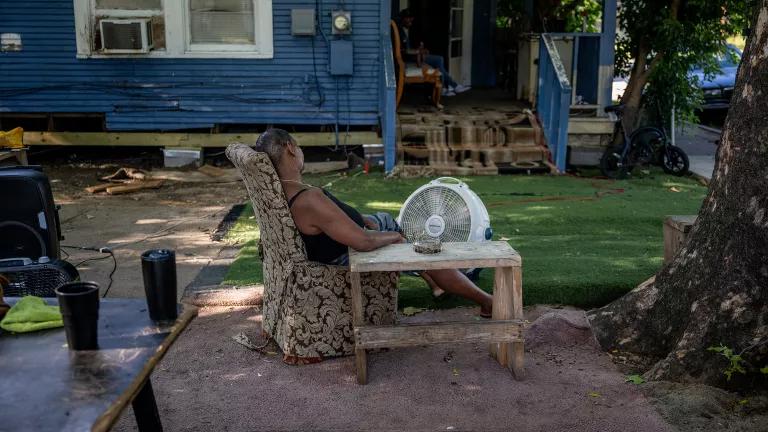Electric Utilities’ Energy Efficiency Progress in 2019
America’s electric utilities have emerged as essential partners in the nation’s ongoing clean energy transition, as acknowledged forcefully in a joint statement last year by their principal trade association and NRDC, and that continued throughout 2019 (although we don’t, of course, always agree on energy policy issues).

Part of NRDC's Year-End Series Reviewing 2019 Climate & Clean Energy Developments
America’s electric utilities have emerged as essential partners in the nation’s ongoing clean energy transition, as acknowledged forcefully in a joint statement last year by their principal trade association and NRDC, and that continued throughout 2019 (although we don’t, of course, always agree on energy policy issues).
This year’s utility sector highlights include (from NRDC's recent Annual Energy Report):
- Wind and solar generation capacity is four times greater and coal consumption is 47 percent lower than predicted by the federal government a decade ago (unfortunately, gas consumption is 27 percent higher).
- Among the 25 states with greenhouse gas-reduction targets, six—plus Washington, D.C., and Puerto Rico—and nine large utilities are now committed to 100 percent carbon-free power no later than 2050, meaning that more than 44.5 million U.S. homes and businesses are in a state or utility service area committed to 100 percent clean electricity.
- U.S. utilities are investing $8 billion annually in energy efficiency programs, saving more electricity than produced annually by eight coal-fired power plants.
- The clean energy transition has saved billions for everyday Americans. Household spending on electricity (as a percentage of total spending) has dropped to some of the lowest levels on record. In 2018 U.S. households spent just 1.35 percent of their income on electricity. In the 1980s, by contrast, households spent about 2.2 percent of their income on electricity.
The most important source of affordable clean energy solutions has been—and remains—energy efficiency: smarter use of energy throughout the economy has resulted consistently in better service and lower electricity needs. The Public Utilities Fortnightly recently featured a dialogue between me and the Brattle Group’s Ahmad Faruqui, reprising the multi-decade record and future promise of energy efficiency. What started out as a debate emerged in the end as shared reflections on truly epic efficiency achievements, of which all utility customers share ownership.
The dialogue starts with the bottom line, from a frequently cited Bipartisan Policy Center study that NRDC coauthored: “Over the last four decades, energy savings achieved through improvements in energy productivity have exceeded the contribution from all new supply resources in meeting America’s growing energy needs.” Ahmad and I also highlighted regional progress, starting with the Pacific Northwest and California, and acknowledging contributions from every part of the nation. Utilities have helped by providing financial incentives for efficiency improvements in buildings and equipment, while lending their support to regular upgrades in government efficiency standards.
Utilities have been invaluable efficiency partners despite what looks on the surface like a fundamental conflict of interest: doesn’t the hometown electric company’s financial health inevitably depend on increases in electricity use? History shows the contrary, thanks to a reform long championed by NRDC and other clean energy advocates, along with many utility leaders. “Revenue decoupling” uses small annual rate adjustments (both up and down) to ensure that fluctuations in sales don’t affect utilities’ ability to recover their authorized costs. This recently updated map shows the results of NRDC advocacy in more than two-thirds of the states, including all those that now have revenue decoupling for at least one electric or natural gas utility (32 plus DC), and the number of utilities covered by decoupling mechanisms (109).
The first revenue decoupling mechanism was approved by NRDC co-founder John Bryson when he was president of the California Public Utilities Commission, and nearly all of the subsequent adoptions reflect NRDC engagement, which also figures prominently in an extensive body of empirical studies and expert testimony. Much remains to do here, of course (more than half the states still lack decoupling for electric utilities, for example, and the fraction of revenues covered by these mechanisms for the investor-owned electricity and natural gas sectors is about two-fifths).
Abundant evidence now supports the vital importance of this business model reform for effective utility engagement on both energy efficiency and small-scale renewable energy development. The progress to date is a tribute to dozens of NRDC staff, partners like the Regulatory Assistance Project and the American Council for an Energy-Efficient Economy, and numerous utilities, which now include both investor-owned and publicly owned companies (including the New York Power Authority and the Los Angeles Department of Water and Power).
Once they’ve broken free of addiction to electricity sales increases, utilities can contribute in numerous ways to progress on energy efficiency. Examples include sponsoring America’s annual Energy Efficiency Day and championing energy efficiency standards for buildings and equipment. In May of 2019, utilities serving 42 states and the District of Columbia were among the prominent supporters of efficiency standards for lightbulbs in a proceeding before the U.S. Department of Energy, fighting to protect electricity savings worth an average of $100 per household. Overall, if defenders prevail in these and other battles against proposed federal rollbacks, appliance and equipment efficiency standards will save U.S. homes and businesses nearly $2 trillion on utility bills by 2030.
Utilities’ efficiency story is far from over, but it remains a beacon of hope in the battle against destructive climate change and more localized pollution damage from air and water pollution. But we must do much more to meet national and global climate goals, and another urgent and inadequately appreciated priority is equal access to clean and affordable energy for everyone. Utility engagement will remain invaluable for all of these purposes.



